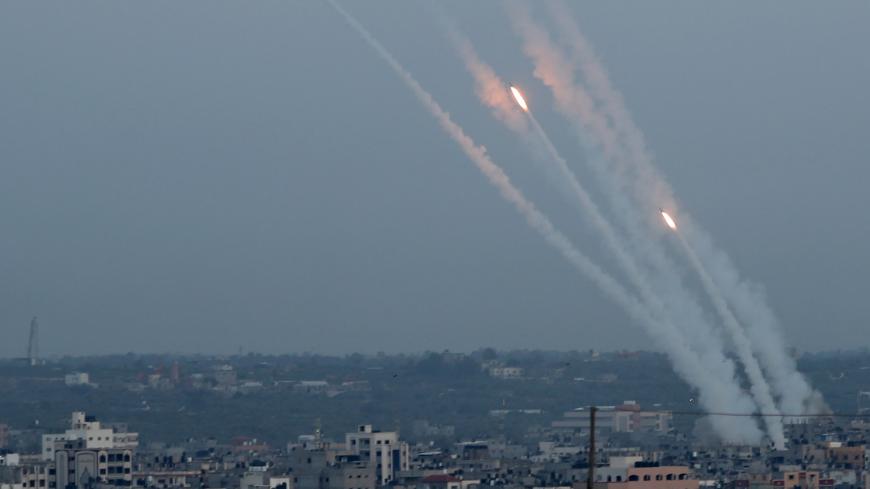A cease-fire came into effect the morning of May 6 after three days of fighting between Israel and Palestinian militant factions in Gaza that led to the deaths of 27 Palestinians and four Israelis.
The cease-fire, which was mediated by Egypt and Qatar, was based on Israel easing the blockade in accordance with understandings previously reached with Palestinian factions, Palestinian officials said.
Wisam Zoghbor, a senior official from the Democratic Front for the Liberation of Palestine, told Al-Monitor, “The cease-fire agreement includes stopping the Israeli aggression on the Palestinian people and the commitment of Israel to implement measures to ease its blockade on Gaza, including the opening of the crossings.”
“The agreement also stipulates that Israel will stop the targeting of fishermen, farmers and peaceful demonstrators in the 'March of Return' protests,” Zoghbor added.
Zoghbor stressed that the Palestinian militant factions will commit to the cease-fire only if Israel commits to ending its aggression against the peaceful demonstrators near the borders, and only if Israel starts "immediately" implementing measures to ease the blockade on Gaza in accordance with previous understandings.
“The reason behind the recent escalation was Israel’s intransigence on maintaining the blockade on Gaza and its refusal to commit to any of the understandings reached with the Palestinian factions to introduce measures that would alleviate the blockade,” Palestinian political analyst Muhammad Hejazi told Al-Monitor.
“It is unknown now whether Israel will live up this time to its commitments made in this cease-fire agreement or whether it’s again trying to buy time and achieve temporary quiet with empty promises. If it’s the latter, we can expect further tensions and escalations soon, as the Palestinian factions will keep pushing and pressuring Israel to lift the blockade on the Gaza Strip," Hejazi added.
In the past year, with the mediation of Egypt, multiple understandings were reached between Gaza’s factions and Israel in which Israel promised to ease the blockade on Gaza in return for a distancing of Gaza’s protests from the border fence, and an end to nightly riots and the dispatching of incendiary balloons into southern Israel. But Palestinians say Israel never implemented any of the understandings reached.
The recent flare-up was the most serious escalation since November. The escalation started after Israel, on May 3, killed two protesters at the border and bombed a Hamas military post, killing two members of the Islamist movement.
Palestinian factions responded hours later by wounding two Israeli soldiers near the border with sniper fire. The next day the factions launched hundreds of rockets into southern Israel.
Israeli warplanes and gunboats in response started a campaign of massive strikes in the Gaza Strip, most of which were on civilian targets.
Twenty-seven Palestinians have been killed by Israeli bombing in this escalation and around 154 Palestinians have been wounded, according to the Palestinian Ministry of Health.
Palestinian victims included two pregnant women and three infants.
On the night of May 5 in Beit Layiha, a town in the north of Gaza, an Israeli airstrike hit a residential building, killing a family of three: Ahmed al-Ghazali, 31, Iman Osrof, 30, and their 4-month-old baby, Maria al-Ghazali.
Israeli warplanes have targeted more than 350 sites across the besieged enclave in the past three days. This included the destruction of large, multistory buildings that house dozens of families.
“The policy of destroying multistory buildings has been adopted by Israel since the 2014 war and has been used in every escalation since then; the policy is intended to pressure the Palestinian factions back into passivity through exacting a hefty price on the civilian population of Gaza,” political analyst and Haaretz contributor Muhammad Shehada told Al-Monitor.
In one such attack, an eight-story building in al-Rimal in Gaza was leveled by Israeli airstrikes.
Subhi al-Khozondar told Al-Monitor, “Israel destroyed my dream and my family’s dream in an instant.”
Khozondar said the building includes his family’s apartment and business, as well as his own new apartment that he just recently furnished.
Khozondar added, “The building is home to dozens of families, and it also has in it an educational facility and an international charity organization.”
“There is absolutely no justification for destroying the building, and for this war crime that Israel committed. Look in the rubble, and you’ll see only clothes, furniture and books and all kinds of innocent civilian stuff.
“There wasn’t an arms factory or a nuclear facility in the building.”
Around 130 building units were completely destroyed and 700 partially destroyed in the past three days, according to the Palestinian Public Works Ministry.
Israel also shelled Hamas and Islamic Jihad military sites, and targeted some of their militants.
On May 5, two Israeli airstrikes killed four fighters from Saraya al-Quds brigades, the military wing of Islamic Jihad.
That afternoon, a 34-year-old military commander from Hamas named Hamad al-Khodari was assassinated in a targeted strike while in his car in the Daraj neighborhood, in the center of Gaza city. The Israeli army statement said Khodari was responsible for “transferring large sums of money” from Iran to armed factions in Gaza.
In Israel, four people were killed due to injuries caused by the rockets launched by Palestinian militant groups.
Multiple Knesset members severely attacked Netanyahu and accused him of surrendering to Hamas and demanded a more violent military action on Gaza.
But the Israeli human rights organization Gisha said, “There is no military solution that can usher in long-term quiet.”
The statement added, “Regional stability will only be made possible once Israel makes substantial, forthright steps to protect the human rights of Gaza’s 2 million residents and allow the Strip’s shattered economy to recover and develop. Cease-fire agreements and 'gestures' by Israel to 'ease' the closure on Gaza cannot substitute long-term solutions, including an end to the occupation.”







